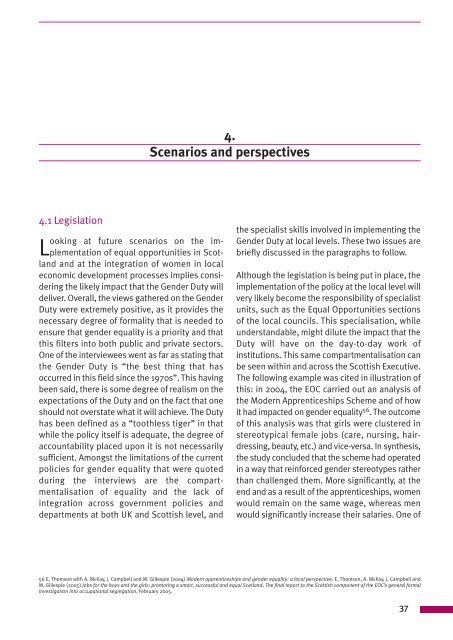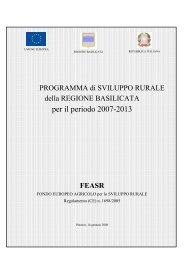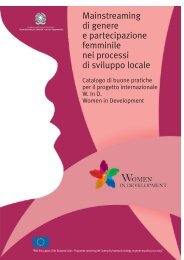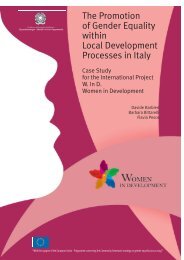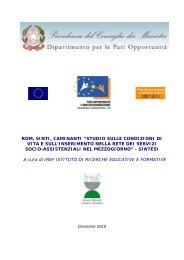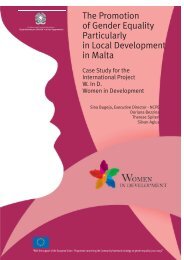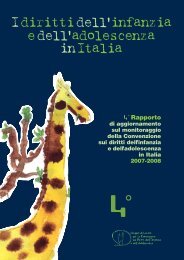4.Scenarios and perspectives4.1 LegislationLooking at future scenarios on the implementationof equal opportunities in Scotlandand at the integration of women in localeconomic development processes implies consideringthe likely impact that the Gender Duty willdeliver. Overall, the views gathered on the GenderDuty were extremely positive, as it provides thenecessary degree of formality that is needed toensure that gender equality is a priority and thatthis filters into both public and private sectors.One of the interviewees went as far as stating thatthe Gender Duty is “the best thing that hasoccurred in this field since the 1970s”. This havingbeen said, there is some degree of realism on theexpectations of the Duty and on the fact that oneshould not overstate what it will achieve. The Dutyhas been defined as a “toothless tiger” in thatwhile the policy itself is adequate, the degree ofaccountability placed upon it is not necessarilysufficient. Amongst the limitations of the currentpolicies for gender equality that were quotedduring the interviews are the compartmentalisationof equality and the lack ofintegration across government policies anddepartments at both UK and Scottish level, andthe specialist skills involved in implementing theGender Duty at local levels. These two issues arebriefly discussed in the paragraphs to fol<strong>low</strong>.Although the legislation is being put in place, theimplementation of the policy at the local level willvery likely become the responsibility of specialistunits, such as the Equal Opportunities sectionsof the local councils. This specialisation, whileunderstandable, might dilute the impact that theDuty will have on the day-to-day work ofinstitutions. This same compartmentalisation canbe seen within and across the Scottish Executive.The fol<strong>low</strong>ing example was cited in illustration ofthis: in 2004, the EOC carried out an analysis ofthe Modern Apprenticeships Scheme and of howit had impacted on gender equality 56 . The outcomeof this analysis was that girls were clustered instereotypical female jobs (care, nursing, hairdressing,beauty, etc.) and vice-versa. In synthesis,the study concluded that the scheme had operatedin a way that reinforced gender stereotypes ratherthan challenged them. More significantly, at theend and as a result of the apprenticeships, womenwould remain on the same wage, whereas menwould significantly increase their salaries. One of56 E. Thomson with A. McKay, J. Campbell and M. Gillespie (2004) Modern apprenticeships and gender equality: a local perspective. E. Thomson, A. McKay, J. Campbell andM. Gillespie (2005) Jobs for the boys and the girls: promoting a smart, successful and equal Scotland. The final report to the Scottish component of the EOC’s general formalinvestigation into occupational segregation, February 2005.37
Gender Equality in Local Economic Development in Scotlandthe recommendations of the report was that anational strategy should be developed to look atoccupational segregation. The Department forEnterprise, Transport and Life-Long Learning(ETLLD), however, has not embraced the findingsof the report when reviewing the ModernApprenticeship Scheme at the start of 2007.Although there was consultation on the ModernApprenticeship Scheme, the consultationdocument did not make any mention of genderissues and equality. This having been said,however, it should also be mentioned that, inresponding to the EOC’s analysis on ModernApprenticeships, the Scottish Executive agreed toset up a Cross-Departmental Working Group onOccupational Segregation. This Group, whichworks across three departments (ETLLD,Education and Development), has been taskedwith exploring the issue of occupationalsegregation thematically - across education,training, careers advise, workforce, curriculum,etc. - and identifying where changes could bemade to policy and practice to challenge genderstereotypes and support women and men, girlsand boys to fulfil their potential in education,employment and training, without being inhibitedby stereotypes and assumptions.A further problem with the implementation of theGender Equality Duty relates to the difficultiesassociated with its practical delivery and thespecialist skills required to comply with it, forexample at the local level. Even the specialistEqual Opportunities staff are reported to bestruggling with the implications of the new GenderDuty, and are finding it much more difficult to dealwith than disability or race as an equality issue. Forexample, Councils may be unsure of how toproceed with surveying all the men and womenlocated within the authority’s boundaries toidentify the main issues pertaining to them.Feedback implies that, at local level, evenspecialists are unsure of how to handle the GenderDuty.4.2 Role of the European CommissionThere was wide consensus amongst theinterviewees that the EC has been extremelyinfluential and that good practices in this fieldwere almost always funded by the Europeanbudget. The dissemination of best practice is alsoconsidered to have been beneficial to make surethat across the EU “everybody is singing from thesame song-sheet” and that there is a commonunderstanding of these issues, and to buildcapacities across Member States. On one level,some events organised by the Commission wereconsidered enjoyable but also at times superficial;on another level, however, there is overall a highconsideration for the trans-national work done atEU level and the active role of the Commission inpromoting good practice exchange across MemberStates. This was considered positive not just forthe promotion of the equality agenda per se, butalso because it builds a sense of the Union. Ofcourse, European Directives are also consideredto have been a strong tool to push throughlegislation the Equal Opportunities agenda 57 .4.3 Role of national and localgovernmentsAccording to one of the interviewees, the UKgovernment has proven to be more risk averseand more focused on business than Scotland andWales; this might have to do with political historyand with the fact that, in England, there is a highernumber of businesses that can effectively lobbythe government. The Scottish Code of Practice ongender duty was for example considered betterthan the English equivalent. One could arguetherefore that devolution has had a positiveimpact in pushing the gender equality agenda inScotland and, in fact, gender equality and equalitymore generally have been at the heart of Scottishpolicies since devolution. However, there seems tobe some degree of tension between UK and57 http://ec.europa.eu/employment_social/gender_equality/legislation/legalacts_en.html.38


